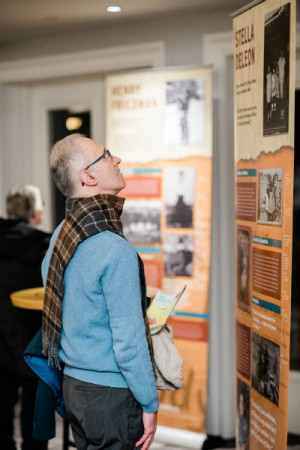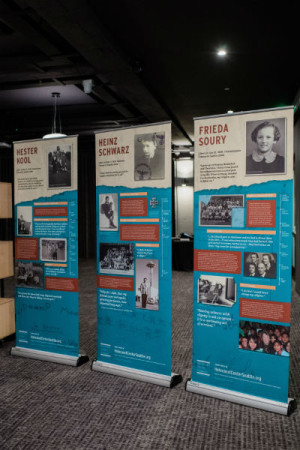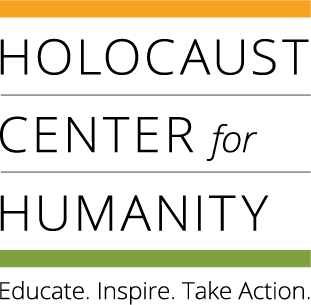
The Holocaust Center for Humanity's “Stories Among Us” exhibit consists of nine stories from the Holocaust, as told through the experiences of survivors that live or have lived in Washington State. Although the Holocaust occurred in Europe, there were, and still are, impacts of the Holocaust felt in our own communities in Washington State.
Details and Frequently Asked Questions
 Q: What is the exhibit concept?
Q: What is the exhibit concept?
A: Each survivor’s story in this exhibit provides a different perspective of the Holocaust – from a refugee, to a hidden child, to a camp prisoner. Through personal stories, primary sources reproduced in this exhibit, and concise, engaging text, “Stories Among Us” is an opportunity for students of all ages to explore the connections between themselves and this important piece of history.
Q: For which audiences is the exhibition appropriate?
A: “Stories Among Us” is appropriate for grades 8 and up. The exhibit may be rented by schools and universities, community centers and groups, religious congregations, libraries, and more.
Q: What’s included in the exhibit, and what is the content like?
A: You can choose to rent the full set (ten banners) or a half set (five banners). Both options consist of retractable banners with attached stands and hard cases. > Photo: Connor Ferguson
An Introductory Panel (included with both the full and half set rentals) provides a definition of the Holocaust, map of Europe, and basic information about the survivors featured. The remaining banners each depict a different Holocaust survivor who made their home in Washington:
- Steve Adler, traveled alone on a Kindertransport from Berlin to England at the age of 8.
- Stella DeLeon, an Auschwitz survivor from the Island of Rhodes.
- Henry Friedman, a child hidden for 18 months by a Polis h family.
- Ed Kaye, a Jewish partisan in the forests of Poland.
- Hester Kool, survived as a nanny, in hiding, to three children in the Netherlands.
- Magda Schaloum, a Hungarian survivor of Auschwitz.
- Heinz Schwarz, a refugee who fled to Shanghai, China.
 Frieda Soury, daughter of a Jewish father and non-Jewish mother, who survived two years in Terezin as a teenager.
Frieda Soury, daughter of a Jewish father and non-Jewish mother, who survived two years in Terezin as a teenager.- Klaus and Paula Stern, a Jewish-German couple sent to Auschwitz.
If renting the full set, you will receive all nine Survivor Panels in addition to the Introductory Panel. If renting the half set, you will receive a selection of four Survivor Panels (if there is a specific survivor(s) you’d like to include in your rental let us know!).
Q: What kind of venue, space, or event should host the exhibit?
A: The room for the exhibit’s display should be at least 250 square feet. The exhibit can be set up in numerous configurations – it does not need to be linear. Each banner is 3 feet wide and 8 feet tall. If you have limited space or specific needs, it is possible to borrow 1-9 banners instead of the entire exhibit. The exhibit can be rented for display at a maximum of four weeks. Rental periods can be arranged for a one-time event only or for ongoing display.
Q: How much does it cost, and what are the expectations between the Holocaust Center and renter?
A: New this year! Stories Among Us is free for Washington state educators. You may borrow the full set of 10 panels or a half set of 5 panels. For other organizations interested in renting Stories Among Us, there is a $500 deposit for the full set of ten panels. For the half set, there is a $250 deposit. Your organization will be invoiced, and deposit must be received at least two weeks prior to loan period. Half of the deposit ($250 for the full set, $125 for the half set) will be refunded when the exhibit has been inventoried and evaluated for damage.
Please note that the exhibit cannot be shipped: renters must be able to pick it up at the Holocaust Center and drop off after the rental period. The renter is expected to take good care of the exhibit, set up the banners carefully and according to the instructions provided, disseminate information to your intended audience to encourage visitation, and include the Holocaust Center’s name and logo in public relations. In turn, the Holocaust Center can help with publicity, provide accompanying programming such as speaker presentations, field trips, or educational materials, and coordinate pick-up and drop-off of the exhibit at the Center with renter in a timely manner. A rental contract will be drawn up and signed between the Holocaust Center for Humanity and the renter outlining all terms.
This exhibit is made possible in part by generous funding from the Jewish Federation of Greater Seattle 2019 Ignition Grant. Special thanks to Chalkbox Creative and the Whitman College History Department.
